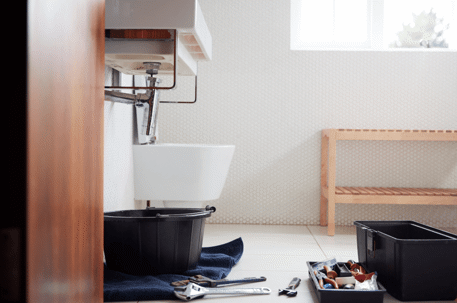Bathroom plumbing, while complex at a glance, is grounded in a systematic methodology. Whether you’re embarking on a renovation or crafting a brand-new space, understanding the inner workings of your bathroom’s plumbing can prove invaluable. Let’s dive into the intricate journey from blueprint crafting to setting up functional plumbing systems.
How to Design Bathroom Plumbing
- Understanding Your Bathroom’s Anatomy: Before any plumbing decisions are made, one must thoroughly analyze the bathroom’s dimensions and structure. The room’s size and shape are foundational in the subsequent plumbing design process.
- Choosing Core Fixtures: The decision on where you’ll place the sinks, toilets, tubs, or showers is paramount. Placement impacts both aesthetics and function. Ideally, you’d want these fixtures close to existing water lines to enhance cost-effectiveness.
- Ensuring Proper Ventilation: Vents are more than just a luxury; they’re a necessity. Proper venting guarantees effective drainage and prevents the ingress of dangerous sewer gases. Each fixture, whether it’s a sink or a bathtub, requires its own vent.
- Accommodating for the Water Heater: Planning to indulge in an expansive bathtub or a luxury shower? Ensure your water heater can handle the increased demand. You might need to upgrade or recalibrate your current system.
How to Layout Plumbing for Bathroom
- Tapping into the Water Supply: Identify the best point to connect with the primary water supply. This pivotal step is all about accessibility and efficiency.
- Optimizing Drainage Placement: The drainage’s centralized point, typically found beneath the bathroom, should enable a smooth, direct connection to the primary sewer line.
- Spacing and Symmetry: It’s not just about function; aesthetics also play a role. Ensure fixtures are neither too close nor too far apart. Additionally, consider the path each plumbing route will take, avoiding unnecessary overlaps.
How to Plan Plumbing for Bathroom
- Maintaining Consistent Water Pressure: Water pressure needs to be just right. If you’re dealing with a multi-level residence, ensure that the upper floors receive sufficient water pressure.
- Incorporating Proper Drain Slopes: To facilitate seamless water flow, drains should have a gentle slope, preventing water stagnation and clog formation.
- Distinguishing Hot and Cold Lines: Keeping these lines separate and adequately insulated is crucial. Proper insulation minimizes energy wastage and prevents pipes from “sweating.”
How to Set Up Bathroom Plumbing
- Material Choices for Pipes: PVC pipes are commonly chosen for drainage due to their resilience. For water supply lines, the flexibility of PEX or the robustness of copper pipes are popular choices.
- Securing the Fixtures: With the foundation (pipes) laid, you’ll move on to fixture installation. Proper alignment and securement are vital at this stage to prevent future complications.
- The All-Important Testing: Once the system is in place, it’s time to test. Check for leaks, evaluate drainage efficiency, and ensure consistent pressure.
How to Set Up Plumbing Framework
- Ensuring Leak-Proof Joints: All pipe joints need meticulous sealing, achieved with plumber’s tape or joint compounds specific to the material.
- Winterizing with Insulation: Especially crucial in colder regions, insulating your pipes can prevent freezing and subsequent damage during winter months.
- Future-Proofing the Design: Consider the long-term. Establishing easily accessible points can streamline potential future repairs or upgrades.
Frequently Asked Questions
What materials are recommended for bathroom pipes?
While the content mainly discussed the layout and planning of bathroom plumbing, pipe material is crucial too. Typically, copper, PVC, and CPVC are popular choices. Consult R.S. Andrews plumbers to determine the best material for your specific needs.
How long does a typical bathroom plumbing project take?
The duration can vary based on the complexity of the project. A simple replacement might take a day, while a full bathroom plumbing redesign could take a week or more.
How often should bathroom plumbing be inspected?
Even if everything seems fine, it’s a good practice to have your bathroom plumbing inspected every two years. Regular inspections can help catch issues before they become significant problems.
Can I DIY my bathroom plumbing?
While some minor tasks can be done on your own, it’s always recommended to consult or hire professional plumbing services for major projects to ensure everything is done correctly and up to code.
How do I deal with low water pressure in my bathroom?
Low water pressure could be due to various reasons, from clogged pipes to issues in the main water line. If you experience this issue, it’s best to get a professional assessment to pinpoint and rectify the cause.
The Bottom Line
Bathroom plumbing is a blend of thoughtful design and practical tasks. From the planning stage to the final setup, every detail counts. This guide is a helpful starting point, but keep in mind that each bathroom has unique needs. If you have questions or want top-notch results, it’s wise to consult with R.S. Andrews plumbers for professional plumbing services. Proper plumbing ensures that your bathroom will not only function well but also be a relaxing space for years to come.

